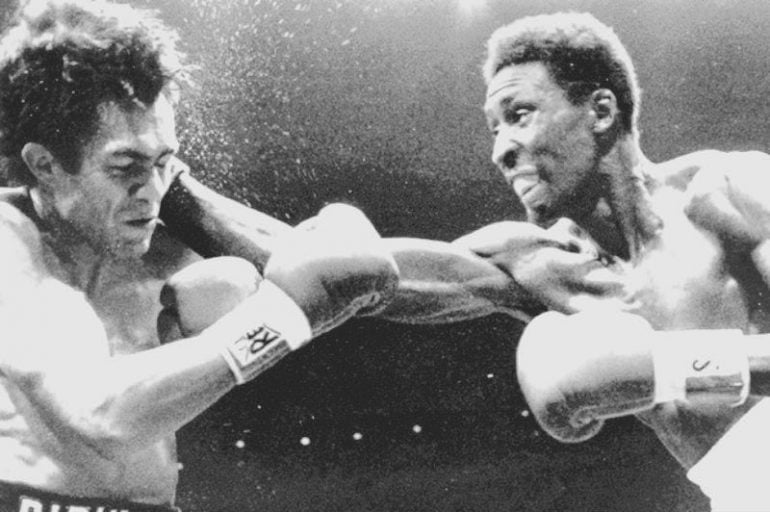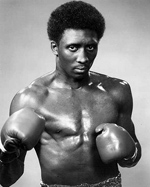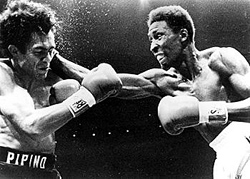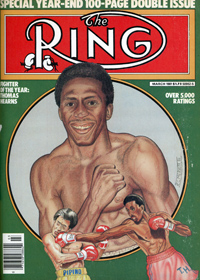Aug. 2, 1980: A day that changed boxing

Mere minutes after certifying Pryor’s spectacular triumph, ring announcer Jimmy Lennon Sr. was on his way to the airport, where he would fly to Detroit to work the night-time card at Joe Louis Arena. After Cobb broke Shavers’ jaw en route to an eighth round TKO and Kenty administered a leather shower to Oh in registering a ninth round TKO, challenger Thomas Hearns entered the ring to ear-splitting cheers. Then, as now, Detroit was a struggling city hungering for a hero and the spindly-legged but broad-shouldered 6-foot-1 Hearns hungered to be that hero.
 Hearns’ stylistic transformation from amateur to pro couldn’t have been more stark. As a simon pure Hearns scored just 12 knockouts in his 155-8 record, which translates to a .074 knockout percentage. But once he turned pro he learned the wonders of leverage and the results were nothing short of spectacular. Hearns ran off 17 consecutive knockout victories to begin his career and entering the Cuevas fight his record was an intimidating 28-0 (26) – a .929 knockout percentage.
Hearns’ stylistic transformation from amateur to pro couldn’t have been more stark. As a simon pure Hearns scored just 12 knockouts in his 155-8 record, which translates to a .074 knockout percentage. But once he turned pro he learned the wonders of leverage and the results were nothing short of spectacular. Hearns ran off 17 consecutive knockout victories to begin his career and entering the Cuevas fight his record was an intimidating 28-0 (26) – a .929 knockout percentage.
“As an amateur, he was just a super boxer,” trainer Emanuel Steward said at the time. “He’d jab, jab, jab, fire his right, then dance away. He didn’t know what a left hook was and he didn’t know what leverage was. Then he started to grow and started to learn. The power was always there, only he didn’t know how to use it. Now he does, and the results, as you have seen, are awesome.”
What was equally awesome was the reputation crafted by the hard-hitting Cuevas. At age 18, Cuevas became history’s youngest welterweight champion by blasting out Angel Espada in two rounds and over the next four years he became arguably the most feared fighter in the sport. His massive left hook wreaked havoc not only on gym equipment (they broke countless speed bags) but also on the facial bones of opponents.
 Espada suffered a broken jaw in two subsequent fights against Cuevas, as did Harold Weston Jr., while former welterweight champion Billy Backus retired after Cuevas fractured his orbital bone. Only the resourceful Randy Shields managed to last the distance during Cuevas’ reign of terror, which, to this point, boasted 11 defenses. At the time of the Hearns fight more than a few experts believed Cuevas to be among history’s greatest welterweight champions and at age 22 he was poised to make even more history.
Espada suffered a broken jaw in two subsequent fights against Cuevas, as did Harold Weston Jr., while former welterweight champion Billy Backus retired after Cuevas fractured his orbital bone. Only the resourceful Randy Shields managed to last the distance during Cuevas’ reign of terror, which, to this point, boasted 11 defenses. At the time of the Hearns fight more than a few experts believed Cuevas to be among history’s greatest welterweight champions and at age 22 he was poised to make even more history.
Cuevas vs. Hearns was billed as “World War II,” for many believed that Roberto Duran or Sugar Ray Leonard, who fought several weeks earlier in Montreal in “World War I,” eventually would meet the winner. But “World War II” ended up being a blitzkrieg for the ages.
The opening exchange of hooks essentially decided the fight. Though Cuevas actually launched his hook a split-second earlier, Hearns’ shorter flight path and quicker trigger managed to beat Cuevas’ to the target. Both blows landed but Hearns’ carried enough force to make Cuevas stagger backward. From that point on, it was one-way traffic.
With Cuevas uncharacteristically circling away, the stalking Hearns fired whipping jabs, thunderbolt crosses and blinding combinations that mightily tested Cuevas’ cast-iron chin. A right to the ear, combined with Cuevas’ leather-soled shoes, caused the champion to slip and another quick cross knocked him into the ropes. The crowd cheered every landed blow and the escalating noise level served to carry Hearns on a tidal wave of momentum that simply couldn’t be stopped.
 As the round reached its final minute Hearns savaged Cuevas with blistering power shots and the champion could do little else but circle away and brace for the next assault. A whistling right buckled Cuevas’ legs and a final double-jab/double cross closed out a dominant first three minutes for the 21-year-old American.
As the round reached its final minute Hearns savaged Cuevas with blistering power shots and the champion could do little else but circle away and brace for the next assault. A whistling right buckled Cuevas’ legs and a final double-jab/double cross closed out a dominant first three minutes for the 21-year-old American.
Hearns speared the still-retreating Cuevas with jabs to open round two and singular right hands landed with alarming frequency. The relatively slow pace was just the interlude before the crushing closing act.
A comet-quick volley of power shots had Cuevas in full retreat and a flush one-two in ring center set the stage for one of Hearns’ signature moments. As both men measured each other with jabs, their left arms tangled for a long moment. Once Hearns drew his bead, he fired a trademark right to the temple that buckled Cuevas’ legs and sent his upper body into a slow-motion spin, while a second right put Cuevas on his face.
Somehow, a woozy Cuevas managed to rise by referee Stanley Christodoulou’s count of eight but Cuevas’  manager Arturo “Cuyo” Hernandez had already climbed into the ring to signal his fighter’s surrender.
manager Arturo “Cuyo” Hernandez had already climbed into the ring to signal his fighter’s surrender.
“If it had been anybody else, I would have been surprised,” Hearns told THE RING’s Randy Gordon shortly after the bout when asked if he was shocked by Cuevas regaining his feet. “But Cuevas had been known for having a great chin. But listen, we’re all human, and when that kind of punch hit you, like the right I hit him with, a man has to drop. It would have frightened me if he didn’t fall!”
In just five minutes and 39 seconds, Hearns had established the building blocks for his eventual Hall of Fame legend while simultaneously destroying Cuevas’. The proof: Hearns was a first-ballot Hall of Famer while Cuevas, once considered a living legend at 22, had to wait a full eight years after he first became eligible before he was honored in 2002. Hearns’ coronation was among the most thrilling and destructive of the young decade, and yet this landmark day had one more huge surprise laying in wait.
(Click the NEXT button to read Page 3 of this article.)















